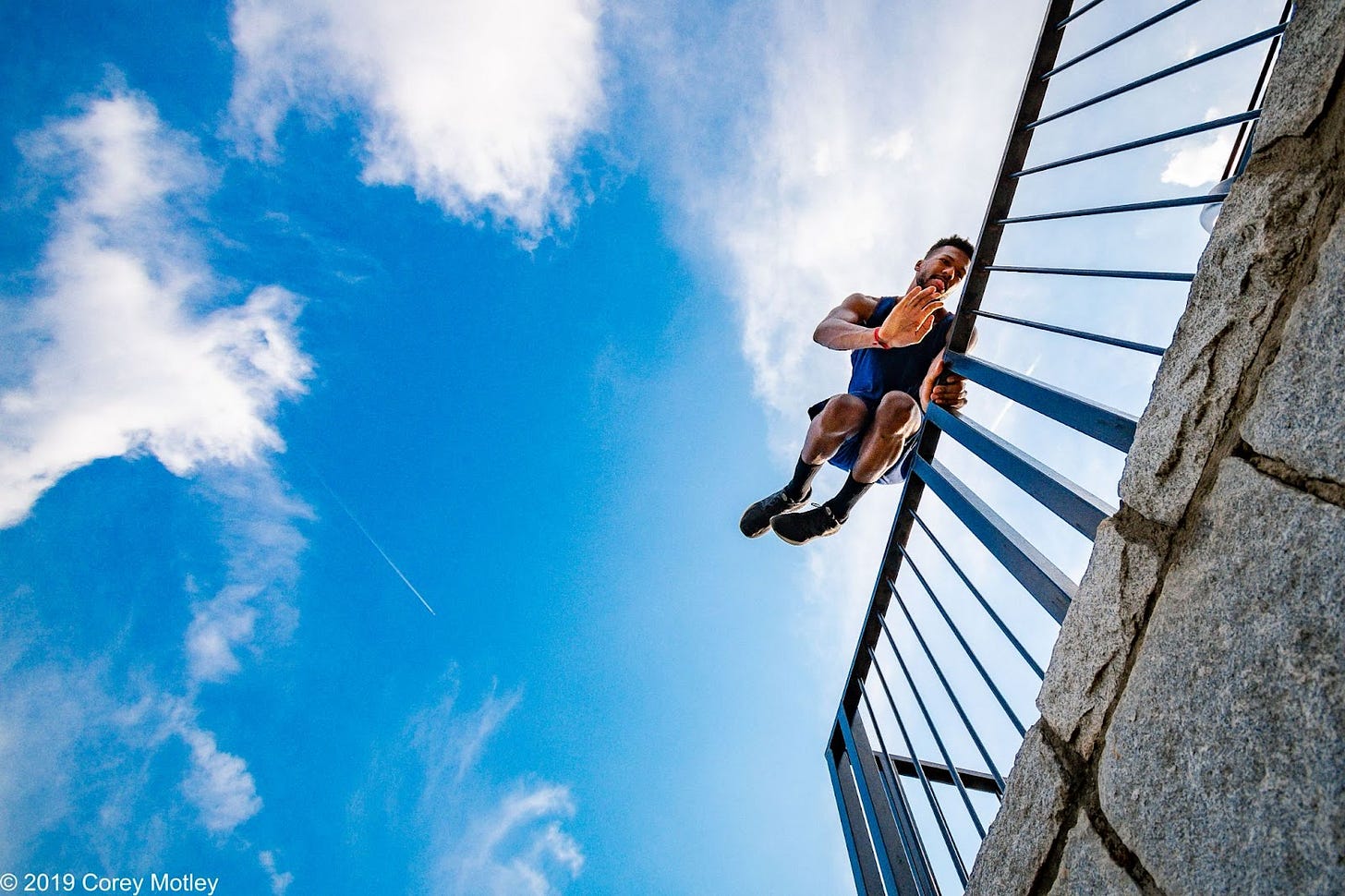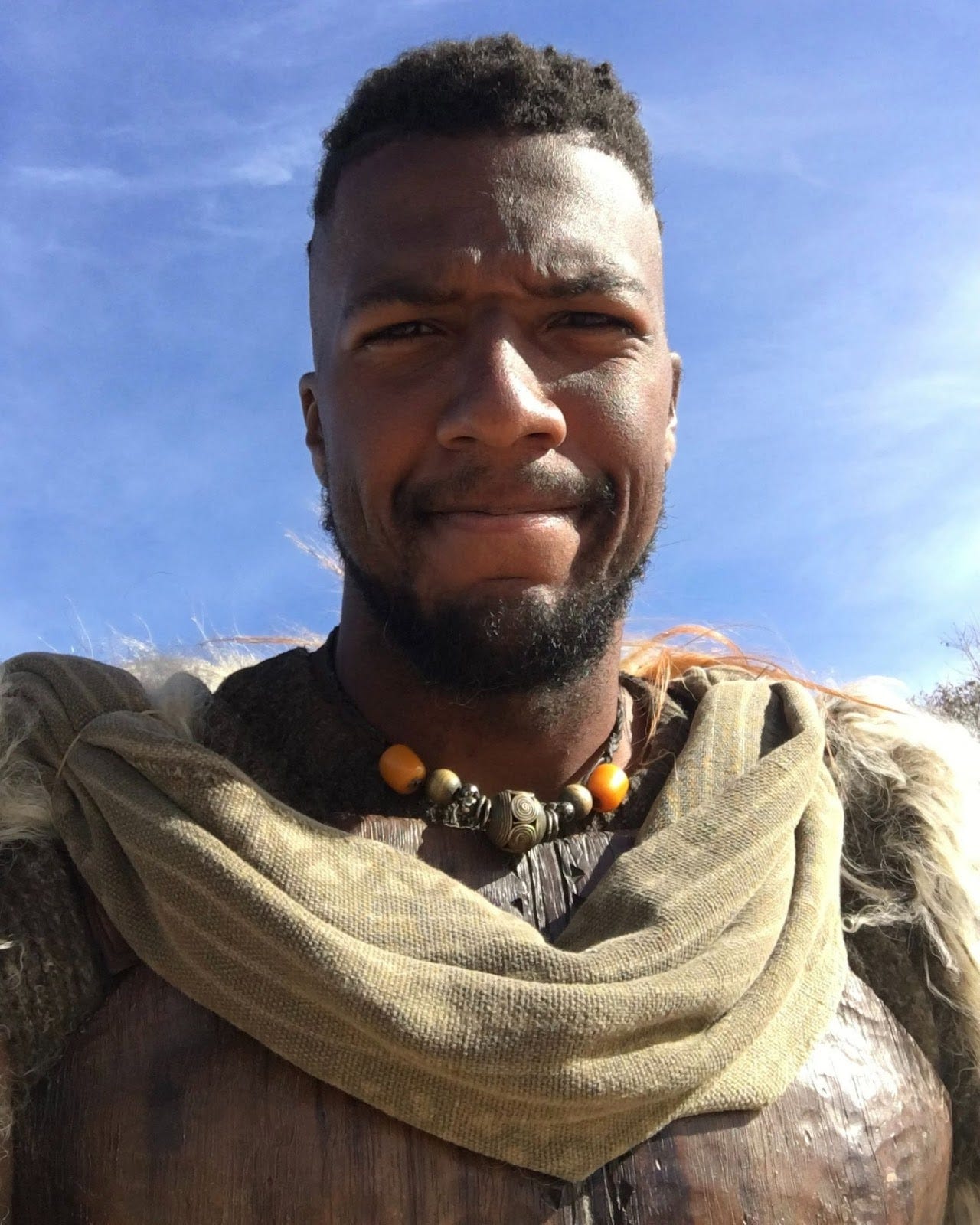Call him the Prince of Parkour
At 6 ft. 10 in., Brian A. Prince seemed destined for a career in basketball. He found his calling in a less obvious place: parkour.

When Brian A. Prince walks into a room, he commands attention.
It’s not because of the clothes he wears or an especially outsized personality, gregarious and lively though he may be. It’s because, at 6 ft. 10 in. tall, Prince usually has to dip his head to make it past a standard, 80-inch door frame.
That’s just not something most people are used to unless they spend a lot of time at basketball games.
Indeed, Prince was born into a hoops family. His mom was 6 ft. 2 in. and his dad played professionally briefly with the Philadelphia 76ers. You would think his future was on the hardwood.
It ended up being more Hollywood. Prince earned a fine arts degree from Savannah College of Art Design and was planning on becoming an illustrator when parkour—the athletic pursuit wherein one tries to get from point A to B as efficiently as possible, using all manner of body-contorting maneuvers—vaulted into his life.
What seemed like a momentary pursuit turned into a passion, which then evolved into a career doing stunt work for films, which led him to acting—including playing a zombie in The Walking Dead and the title creature in The Predator.
How does an almost seven-foot-tall man end up specializing in a sport where the world’s best are at least a foot shorter? And just what was it like to play one of the most feared alien creatures on the big screen? We spoke to him.
How were you introduced to parkour?
I saw the James Bond movie Casino Royale. That opening scene blew my mind. Watching a real human being do this. The guy in that movie, his name is Sébastien Foucan, he's like one of the founders of parkour. He's one of my heroes.
That started me down this hole on the internet on what is parkour. I'm watching a bunch of YouTube videos and I was off [to the races]. I recall the date like it was yesterday: May 14, 2008. I remember having this really clear moment of, “I really want to do this.” The rest is history.

How did parkour lead you into stunt work?
Atlanta is the third-largest filming city in the country outside of New York and Los Angeles. During the growth period [for Atlanta’s film industry], there was this big transition of parkour athletes and martial artists becoming stunt people. My first time officially getting hired as a stuntman was for a Tyler Perry show. The stunt coordinator for the show was training at the same gym where I was learning flips. He asked if I was available for work and it was on from there.
The funny thing is they put me in a wardrobe, did my hair, and gave me this gun for the scene. Tyler Perry walked in, looked at me, said, “he's too tall” and bounced. So I just hung out on set for the rest of the day doing nothing, but I still got paid.
You’ve done stunts for Black Panther, Captain America, and The Walking Dead. Which one was your favorite?
I'd have to say Black Panther just because it was such an honor to be in that movie. I was there for re-shoots; I didn't do principal photography. I saw the first trailer in theaters and thought it would be cool to be in that movie. Then I got a call one day and the stunt coordinator asked if I was available for re-shoots for Black Panther. I got to be a Jabari warrior in the big final battle!
The cool part about it was the pride I felt when others found out about my appearance in the movie. I went to the doctor and the nurse practitioner was an African woman and she's like, “Oh, it says here you're a stunt performer. Have you been in anything I might have heard of?” I was like, “Yeah, I was in Black Panther.” And she screamed!
If I'm at a family reunion, my mom gets to bragging about her baby being in Black Panther. It was a real honor.
Do you believe there should be an Academy Award for stunt work?
Definitely, 100 percent yes. It blows my mind that there's not. It feels like an acknowledgment that's not given to people who are heavily involved with the process.
These are not brainless cowboys, but cinematographers and actors that care deeply for the final product. There's a misconception that some people are there just to get hurt. They are there to take calculated risks and not be expendable.
How did the role of the Predator come about?
I had been doing stunts for a couple of years. I received a call from a stunt coordinator, and he asks if I’m really 6-foot-10 and do parkour. I sent him a video and my résumé. I was in LA the following week auditioning for The Predator.
The audition took place at one of the most popular parkour gyms in the world, called Tempest Freerunning Academy. It's me and four other guys. They ran us through a parkour-style competition, but with acting. I must have really impressed them—the next day, I received the call that I got the role.
It was this whole process of getting fitted for the suit. It took months of them molding my whole body including my face, hands, and feet.
A few months passed before production actually started, but they flew me out to Vancouver, where we began filming, in February. I got to be the Predator and it was the greatest and worst experience I've ever gone through, at the same exact time.
You're going to have to elaborate on that.
It’s funny because I think everybody wants to just imagine that it was the coolest thing ever. But honestly, it was one of the most physically demanding, too.
I’m wearing a suit that’s 85 lbs. when dry, so you can only imagine what it weighs covered in sweat. The head, on its own, weighs 11 pounds—and then you add the animatronics. I was in physical discomfort most of the time.
It's hard. Being the Predator? That was awesome. My previous roles were stunts only, so this was my first full-onset character experience. I was my own actor and stunt double.

You are also a trained illustrator. Where did that skill come from?
It came from Sonic the Hedgehog! The first thing I ever drew was that character. I had the poster in my childhood room, and I would just draw him all the time.
The plan was for me to be an illustrator upon college graduation, but this stunt thing kind of took off.
I’m eventually working my way back to doing it again. I had to cancel my graphic novel contract with Simon and Schuster because of my shoulder injury.
I’m also working on a project with a writer friend of mine. We are pitching it as an animated series.
You mentioned a shoulder injury. Not being able to do parkour and not being able to draw—important aspects of who you are. How are you handling that mentally?
I love that question. The first thing that came to my mind is, you got to admit and accept that the thing that happened and where you're at right now.
When I was injured, I didn't stop immediately. I tried to keep doing stunt work. I tried to keep doing parkour. I tried to keep doing the illustration and graphic novel.
I burnt out really hard.
It's funny. If it’s a car, everyone gets it. If a car has no gas and no oil and no air in the tires, you can’t keep running it.
I was that car. I was just trying so hard and then things just started breaking and I would not admit that they were breaking.
That’s why I tell people, first stop, sit down, and acknowledge what happened. The second thing, feel that pain. And then the third thing is, once you're done feeling it, one thing at a time, try to address it.



